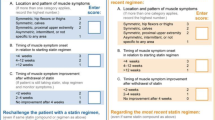Abstract
3-Hydroxy-3-methylglutaryl coenzyme A (HMG-CoA) reductase inhibitors (statins) are safe and effective in lowering low-density lipoprotein cholesterol. As a result, they confer an all-cause mortality benefit across a wide range of patient groups. The utility of statins is limited by their adverse effects, including myalgias and rhabdomyolysis. These clinical events, plus other symptoms, constitute what is termed statin myopathy. This review summarizes current concepts of statin myopathy and presents strategies to minimize statinassociated myopathic complaints.
Similar content being viewed by others
References and Recommended Reading
Murphy SA, Cannon CP, Wiviott SD, et al.: Effect of intensive lipid-lowering therapy on mortality after acute coronary syndrome (a patient-level analysis of the Aggrastat to Zocor and Pravastatin or Atorvastatin Evaluation and Infection Therapy-Thrombolysis in Myocardial Infarction 22 trials). Am J Cardiol 2007, 100:1047–1051.
Bruckert E, Hayem G, Dejager S, et al.: Mild to moderate muscular symptoms with high-dosage statin therapy in hyperlipidemic patients—the PRIMO study. Cardiovasc Drugs Ther 2005, 19:403–414.
Staffa JA, Chang J, Green L: Cerivastatin and reports of fatal rhabdomyolysis. N Engl J Med 2002, 346:539–540.
Kashani A, Phillips CO, Foody JM, et al.: Risks associated with statin therapy: a systematic overview of randomized clinical trials. Circulation 2006, 114:2788–2797.
Ballantyne CM, Corsini A, Davidson MH, et al.: Risk for myopathy with statin therapy in high-risk patients. Arch Intern Med 2003, 163:553–564.
Heart Protection Study Collaborative Group: MRC/BHF Heart Protection Study of cholesterol lowering with simvastatin in 20,536 high-risk individuals: a randomised placebo-controlled trial. Lancet 2002, 360:7–22.
Harper CR, Jacobson TA: The broad spectrum of statin myopathy: from myalgia to rhabdomyolysis. Curr Opin Lipidol 2007, 18:401–408.
Sewright KA, Clarkson PM, Thompson PD: Statin myopathy: incidence, risk factors, and pathophysiology. Curr Atheroscler Rep 2007, 9:389–396.
Pasternak RC, Smith SC Jr, Bairey-Merz CN, et al.; American College of Cardiology; American Heart Association; National Heart, Lung and Blood Institute. ACC/AHA/NHLBI clinical advisory on the use and safety of statins. J Am Coll Cardiol 2002, 40:567–572.
McKenney JM, Davidson MH, Jacobson TA, et al.; National Lipid Association Statin Safety Assessment Task Force. Final conclusions and recommendations of the National Lipid Association Statin Safety Assessment Task Force. Am J Cardiol 2006, 97(Suppl 8A):89C–94C.
Thompson PD, Clarkson PM, Rosenson RS; The National Lipid Association Statin Safety Task Force Muscle Safety Expert Panel. An assessment of statin safety by muscle experts. Am J Cardiol. 2006 97(Suppl 8A):69C–76C.
Sorokin AV, Duncan B, Panetta R, Thompson PD: Rhabdomyolysis associated with pomegranate juice consumption. Am J Cardiol 2006, 98:705–706.
Thompson PD, Clarkson P, Karas RH: Statin-associated myopathy. JAMA 2003, 289:1681–1690.
Goosen TC, Bauman JN, Davis JA, et al.: Atorvastatin glucuronidation is minimally and nonselectively inhibited by the fibrates gemfibrozil, fenofibrate, and fenofibric acid. Drug Metab Dispos 2007, 35:1315–1324.
Prueksaritanont T, Tang C, Qiu Y, et al.: Effects of fibrates on metabolism of statins in human hepatocytes. Drug Metab Dispos 2002, 30:1280–1287.
Kyrklund C, Backman JT, Kivistö KT, et al.: Plasma concentrations of active lovastatin acid are markedly increased by gemfibrozil but not by bezafibrate. Clin Pharmacol Ther 2001, 69:340–345.
Sirvent P, Mercier J, Lacampagne A: New insights into mechanisms of statin-associated myotoxicity. Curr Opin Pharmacol 2008, 8:333–338.
Draeger A, Monastyrskaya K, Mohaupt M, et al.: Statin therapy induces ultrastructural damage in skeletal muscle in patients without myalgia. J Pathol 2006, 210:94–102.
Phillips PS, Haas RH, Bannykh S, et al.; Scripps Mercy Clinical Research Center: Statin-associated myopathy with normal creatine kinase levels. Ann Intern Med 2002, 137:581–585.
Päivä H, Thelen KM, Van Coster R, et al.: High-dose statins and skeletal muscle metabolism in humans: a randomized, controlled trial. Clin Pharmacol Ther 2005, 78:60–68.
Urso ML, Scrimgeour AG, Chen YW, et al.: Analysis of human skeletal muscle after 48 h immobilization reveals alterations in mRNA and protein for extracellular matrix components. J Appl Physiol 2006, 101:1136–1148.
Hanai J, Cao P, Tanksale P, et al.: The muscle-specific ubiquitin ligase atrogin-1/MAFbx mediates statin-induced muscle toxicity. J Clin Invest 2007, 117:3940–3951.
Smogorzewski M: The myopathy of statins. J Ren Nutr 2005, 15:87–93.
Dirks AJ, Jones KM: Statin-induced apoptosis and skeletal myopathy. Am J Physiol Cell Physiol 2006, 291:C1208–C1212.
Rodriguez MC, MacDonald JR, Mahoney DJ, et al.: Beneficial effects of creatine, CoQ10, and lipoic acid in mitochondrial disorders. Muscle Nerve 2007, 35:235–242.
Schon EA, Bonilla E, DiMauro S: Mitochondrial DNA mutations and pathogenesis. J Bioenerg Biomembr 1997, 29:131–149.
Chariot P, Abadia R, Agnus D, et al.: Simvastatin-induced rhabdomyolysis followed by a MELAS syndrome. Am J Med 1993, 94:109–110.
Thomas JE, Lee N, Thompson PD: Statins provoking MELAS syndrome. A case report. Eur Neurol 2007, 57:232–235.
Marcoff L, Thompson PD: The role of coenzyme Q10 in statin-associated myopathy: a systematic review. J Am Coll Cardiol 2007, 49:2231–2237.
Caso G, Kelly P, McNurlan MA, et al.: Effect of coenzyme Q10 on myopathic symptoms in patients treated with statins. Am J Cardiol 2007, 99:1409–1412.
Young JM, Florkowski CM, Molyneux SL, et al.: Effect of coenzyme Q(10) supplementation on simvastatin-induced myalgia. Am J Cardiol 2007, 100:1400–1403.
Thompsen J, Thompson PD: A systematic review of LDL apheresis in the treatment of cardiovascular disease. Atherosclerosis 2006, 189:31–38.
Huang CF, Li TC, Lin CC, et al.: Efficacy of Monascus pupureus West rice on lowering lipid rations in hypercholesterolemic patients. Eur J Cardiovasc Prev Rehabil 2007, 14:438–440.
Juszczyk MA, Seip RL, Thompson PD: Decreasing LDL cholesterol and medication cost with every-other-day statin therapy. Prev Cardiol 2005, 8:197–199.
Backes JM, Venero CV, Gibson CA, et al.: Effectiveness and tolerability of every-other-day rosuvastatin dosing in patients with prior statin intolerance. Ann Pharmacother 2008, 42:341–346.
Gadarla M, Kearns A, Thompson PD: Efficacy of rosuvastatin (5 mg and 10 mg) twice a week in patients intolerant to daily statins. Am J Cardiol 2008, 101:1747–1748.
Author information
Authors and Affiliations
Corresponding author
Rights and permissions
About this article
Cite this article
Siddiqi, S.A., Thompson, P.D. How do you treat patients with myalgia who take statins?. Curr Atheroscler Rep 11, 9–14 (2009). https://doi.org/10.1007/s11883-009-0002-1
Published:
Issue Date:
DOI: https://doi.org/10.1007/s11883-009-0002-1




